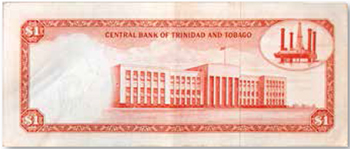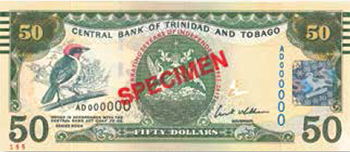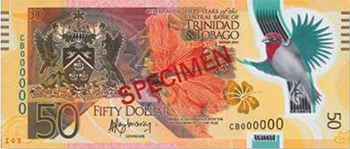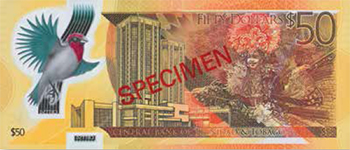Currency Notes
Fifty Marks the Spot
Finance & Development, March 2017, Vol. 54, No. 1
Trinidad and Tobago’s new $50 bill is dressed for a celebration

Trinidad and Tobago got its first national currency in 1964, two years after obtaining independence from Great Britain. In denominations of $1, $5, $10, and $20, each a different color, the bills featured Queen Elizabeth II, Trinidad and Tobago’s coat of arms, its central bank, and an illustration representing a local industry—an offshore oil rig, for example.
Introducing the fifty
In 1977, a year after becoming a republic, the country’s coat of arms took center stage on the notes, replacing Queen Elizabeth, and $50 and $100 notes entered the scene. But the fifty was pulled from circulation just two years later, after a shipment of unissued bills was stolen.

To mark Trinidad and Tobago’s 50th year of independence in 2012, the central bank reintroduced the $50 bill. But it wasn’t readily accepted by the public. Senior citizens had trouble distinguishing the new olive-green bill from the green $5 and gray $10 bills. Some people considered the banknotes collector’s items and were reluctant to spend them. And banks and stores were not prepared for the change: cash drawers had no slot for the new bill. People weren’t using the fifty.

But they were using the $20 and $100 notes, both to save and to make payments—so much so that the central bank had to print more of them. According to the central bank, Trinidad and Tobago had more banknotes in circulation per capita than any other country in the years after the olive-green bills came out. The central bank decided it was time for a new and improved $50 banknote.
Crowning glory
In December 2014 the new note debuted. It was produced by the central bank of Trinidad and Tobago and UK currency printer De La Rue. Part of the reason for problems with the $50 note issued in 2012 was insufficient consultation with stakeholders; the central bank in 2014 engaged in strong consultation with such key stakeholders as banks, businesses, and experts in history and art.

The new $50 note is rich in color and highlights the country’s natural beauty and cultural heritage. The bill’s golden color celebrates the central bank’s 50-year jubilee. Its dramatic design includes a red hibiscus flower, a young woman in carnival attire, and a red-capped cardinal. The bird, whose colors are those of the country’s flag, is poised for flight against a transparent polymer plastic window.

The $50 also has enhanced security features. A small goldgreen iridescent hibiscus flower changes color as you move the bill around, and the micro text of the number 50 can be seen only under a magnifier.
The design won the country the International Bank Note Society’s Banknote of the Year award. Because many older cash-counting machines weren’t prepared to handle the new polymer notes, the central bank teamed up with commercial banks to upgrade technology vital to the processing and handling of the polymer notes, so that citizens would be able to withdraw the new $50 bill from ATMs.
In November 2015, the central bank issued an updated $50 polymer note that removed the commemorative text “Celebrating 50 years of Trinidad and Tobago’s Central Bank,1962–2012” and added raised dots to help those who are visually impaired. And a red banner was added across the tail of the red-capped cardinal as an additional security feature.
The $50 bill has a checkered history, much like the small industrial and high-income economy, which has been colonized by the Spanish, British, French, Dutch, and even the tiny Duchy of Courland. But the country is now leading the way with an ultramodern currency that is striking in its beauty, welcoming to those who cannot see it, and protected from those who would dare compromise it. ■


